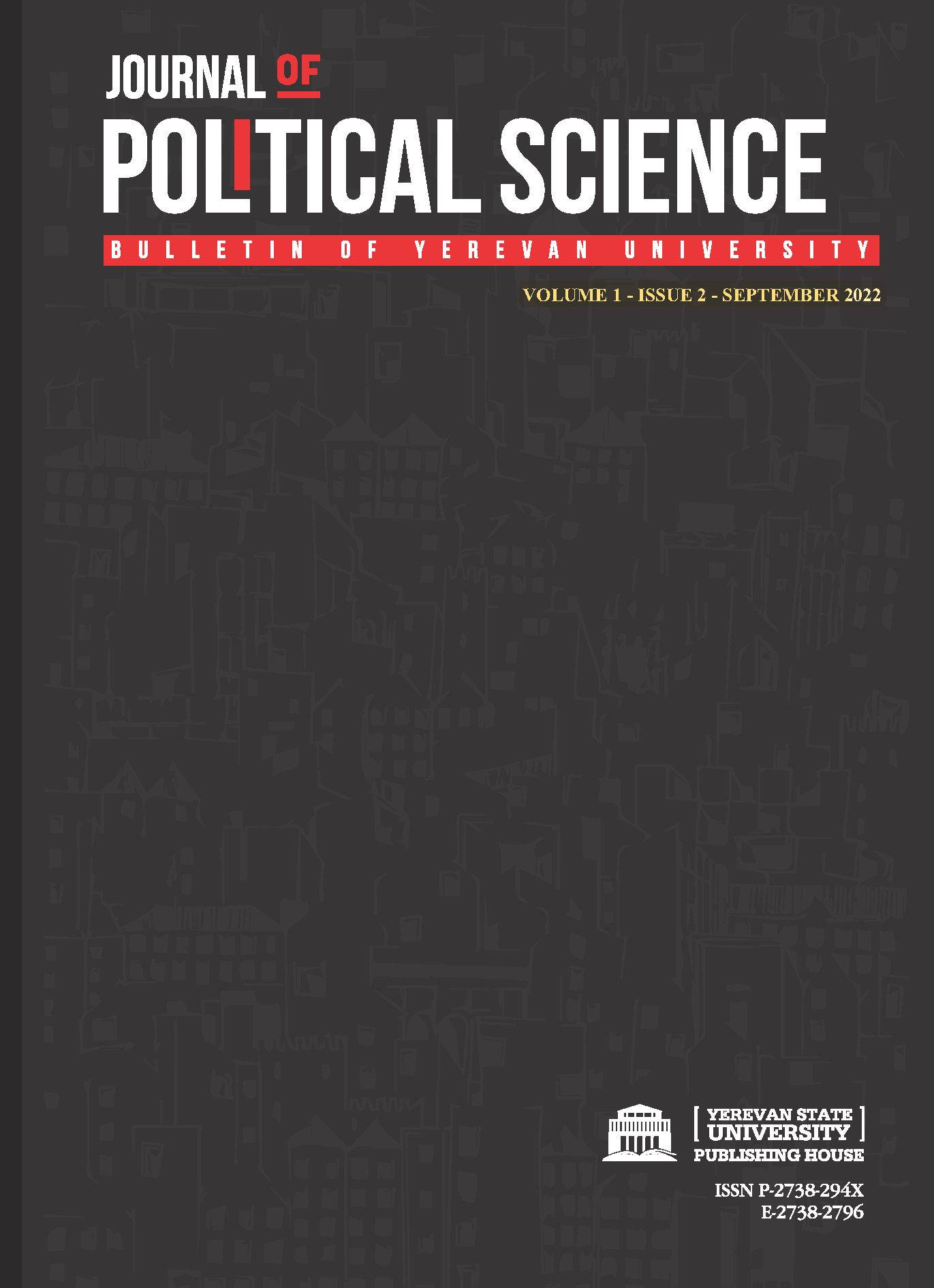Civic Journalism as a Phenomenon of Digital Civilization
DOI:
https://doi.org/10.46991/JOPS/2022.1.2.106Keywords:
Civic journalism, citizen journalism, public journalism, disinformation, misinformation, mal-information, social media, freedom of speech, fake news, democracy, mediacracyAbstract
This article explores the role of citizen journalism in terms of promoting civil society and democracy. Civic journalists, as well as citizen journalists, contribute to public discussion and try to voice and address many issues that have been ignored by traditional journalism. This study aims to explore the relevance of citizen journalism in the modern world. In addition, a negative phenomenon that is widespread in social networks and infringes on human rights, fake news and hate speech on social networks is investigated. Combining qualitative discourse analysis, comparison and description, the study shows that the role of citizen journalism is growing in many countries. However, hate speech and fake news on social media hinder the development of citizen journalism. To this end, further legislative and democratic measures must be taken. However, the most effective way to combat the obstacles to citizen journalism is to promote media literacy, which will enable everyone to comparatively analyze information, check the message and develop critical thinking.
References
Ahmad, Nyarwi, and Ioan-Lucian Popa. 2014. “The Social Media Usage and the Transformation of Political Marketing and Campaigning of the Emerging Democracy in Indonesia.” In: Social Media in Politics. Public Administration and Information Technology, vol 13, edited by Bogdan Pătruţ, and Monica Pătruţ, 97-125. Springer, Cham. https://doi.org/10.1007/978-3-319-04666-2_7.
Ahva, Laura. 2011. “What is ”public” in public journalism?” Estudos em Comunicação -Communication Studies 9:119-142.
Ahva, Laura. 2013. “Public journalism and professional reflexivity.” Journalism 14 (6): 790-806. https://doi.org/10.1177/1464884912455895.
Allcott, Hunt, and Matthew Gentzkow. 2017. “Social Media and Fake News in the 2016 Election.” Journal of Economic Perspectives 31 (2): 211-236. https://doi.org/10.1257/jep.31.2.211.
Barnes, Corinne. 2012. “Citizen journalism vs. traditional journalism: A case for collaboration.” Caribbean Quarterly 58 (2-3): 16-27.
Bayer, Judit, Natalija Bitiukova, Petra Bárd, Judit Szakács, Alberto Alemanno, and Erik Uszkiewicz. 2019. Disinformation and propaganda - impact on the functioning of the rule of law in the EU and its Member States. Brussels: Directorate General for Internal Policies of the Union. Accessed July 2, 2022. http://www.europarl.europa.eu/RegData/etudes/STUD/2019/608864/IPOL_STU(2019)608864_EN.pdf.
Bentley, Clyde H. 2011. “Citizen journalism: Back to the future?” Geopolitics, History, and International Relations 3 (1): 103-118.
Campbell, Vincent. 2015. “Theorizing citizenship in citizen journalism.” Digital Journalism 3 (5): 704-719.
Haciyakupoglu, Gulizar, Jennifer Yang Hui, V. S. Suguna, Dymples Leong, and Muhammad Faizal Bin Abdul Rahman. 2018. Policy Report: Countering fake news: a survey of recent global initiatives. Singapore: S. Rajaratnam School of International Studies, Nanyan. Accessed July 5, 2022. https://www.think-asia.org/bitstream/handle/11540/8063/PR180307_Countering-Fake-News.pdf?sequence=1.
Kulesza, Joanna. 2014. “Social Media Censorship vs. State Responsibility for Human Rights Violations.” In: Social Media in Politics. Public Administration and Information Technology, vol 13, edited by Bogdan Pătruţ, and Monica Pătruţ, 259-280. Springer, Cham. https://doi.org/10.1007/978-3-319-04666-2_15.
Macharashvili, Nino. 2012. “Citizen Journalism and Traditional Media: 5Ws & H.” MA thesis. University of Warwick. https://pdfslide.net/documents/citizen-journalism-and-traditional-media-5ws-h.html?page=2.
McGonagle, Tarlach. 2017. ““Fake news”: False fears or real concerns?” Netherlands Quarterly of Human Rights 35 (4): 203-209. https://doi.org/10.1177/0924051917738685.
McNair, Brian. 2018. Fake News: Falsehood, Fabrication and Fantasy in Journalism. London and New York: Routledge.
Miller, Michael. 2019. Fake News: Separating Truth From Fiction. Minneapolis: Twenty-First Century Books.
Mutsvairo, Bruce, and Susana Salgado. 2022. “Is citizen journalism dead? An examination of recent developments in the field.” Journalism 23 (2): 354-371.
Noor, Rabia. 2017. “Citizen journalism vs. mainstream journalism: A study on challenges posed by amateurs.” Athens Journal of Mass Media and Communications 3 (1): 55-76.
Nuernbergk, Christian. 2022. “Public Sphere Conceptions: Public Sphere Theory.” In: Handbook of Media and Communication Economics: A European Perspective, 1-24. Wiesbaden: Springer Fachmedien Wiesbaden.
Örnebring, Henrik. 2013. “Anything you can do, I can do better? Professional journalists on citizen journalism in six European countries.” International Communication Gazette 75 (1): 35-53.
Posetti, Julie, Cherilyn Ireton, Claire Wardle, Hossein Derakhshan, Alice Matthews, Magda Abu-Fadil, Tom Trewinnard, Fergus Bell, and Alexios Mantzarlis. 2018. Journalism, Fake News and Disinformation: Handbook for Journalism Education and Training. Paris: UNESCO.
Predmerská, Anna K. 2019. “On the Highway to Multiplatform Journalism.” Communication Today 10 (1): 158-160.
Romero, Leocadia D. (2014). On the Web and Contemporary Social Movements. In: Social Media in Politics. Public Administration and Information Technology, vol 13, edited by Bogdan Pătruţ, and Monica Pătruţ, 19-33. Springer, Cham. https://doi.org/10.1007/978-3-319-04666-2_2.
Ruusunoksa, Laura. 2006. “Public journalism and professional culture: Local, regional and national public spheres as contexts of professionalism.” Javnost-The Public 13 (4): 81-98.
Simons, Greg. 2016. “The impact of social media and citizen journalism on mainstream Russian news.” Russian Journal of Communication 8 (1): 33-51.
Tworek, Heidi. 2017. “Political Communications in the Fake News Era: Six Lessons for Europe.” Policy Brief: Transatlantic Academy (February): 1-10.
Vargo, J. Chris, Lei Guo, and Michelle A. Amazeen. 2018. “The agenda-setting power of fake news: A big data analysis of the online media landscape from 2014 to 2016.” New media & Society 20 (5): 2028-2049. https://doi.org/10.1177/14614448177120.
Walters, Kendle. 2011. “Comparative and critical analysis: The roles of civic and traditional journalism.” UNLV Theses, Dissertations, Professional Papers, and Capstones. 1377. http://doi.org/10.34917/3275266.
Wardle, Claire, and Hossein Derakhshan. 2017. “Information Disorder: Toward an interdisciplinary framework for research and policy making. Strasbourg: Council of Europe.” Accessed April 10, 2022. https://rm.coe.int/information-disorder-toward-an-interdisciplinary-framework-for-researc/168076277c.
Wu, Yan, and Matthew Wall. 2019. “Prosumers in a digital multiverse: An investigation of how WeChat is affecting Chinese citizen journalism.” Global Media and China 4 (1): 36-51.
Downloads
Published
How to Cite
Issue
Section
License
Copyright (c) 2022 Greta Gevorgyan

This work is licensed under a Creative Commons Attribution-NonCommercial 4.0 International License.







